Online Barista Training: Another Look at Espresso
Even if you just have started your online barista training, you would have certainly heard of espresso. In today's coffee world, it is synonymous with coffee. But what is it?
Whether you work in a small cafe, chain coffee shop, or a coffee stand, you will want to be familiar with the elements of espresso. Espresso is the essential ingredient of all popular coffee drinks. That's why they are called “espresso-based” drinks. They have in typical espresso; milk, cream, syrups, and everything else depending on a particular coffee recipe.
A “shot” of the espresso is generally referred to as the amount of coffee beverage from an espresso machine at a specific time. It isn't a technical term, nor does it have a predefined amount of mass or volume. A shot can be different for every coffee business or barista.
Therefore, it's essential to realize that a “shot” of the espresso is arbitrary. However, there is a general guideline that many people have that defines a suitable range for a typical espresso shot.
A general espresso definition:
Espresso is created by the pressurized percolation of hot water that flows through a tight puck of ground coffee—the water extracts (washes out) the solids and oils from the grounded coffee's expanded surface.
An espresso shot ranges from 6 grams to 21 grams (approximately) of dry ground coffee. It is extracted by the water running under 7-9 bars of pressure from the espresso machine.
Typically, the extraction time is between 20 to 35 seconds.
The water used to extract the coffee falls between 185 and 205 degrees F (85°C – 96°C).
| Double Espresso | |
| Ground Coffee | 18 grams (0.25 – 0.31. oz.) |
| Water Temperature | 92°-95°c (195°- 205°f) |
| Water Pressure | 9 bars |
| First Drops | Approximately 5-7 seconds |
| Flow Time | About 20-30 seconds |
| Volume | 25-35 ml (.085 – 1 oz. per shot) |
Again, this is a general espresso template. Deviations – though they are relevant – are expected as everyone likes espresso done suitably for them.
Further reading: Requirements to be a Barista.

Online Barista Training: Espresso Fundamentals
You've just read the word “extraction.” What is an extraction? To put it simply, extraction is the removal of mass from through the coffee grounds. This mass consists of soluble and insoluble substances. Soluble solids add to what we taste and the brew strength, while the soluble gasses add to what we smell or the aroma of coffee.
When we talk about drip coffee (that you might brew at home, for example), insolubles are solids and oils that are essentially floating or suspended in the water molecules.
When using the espresso machine, insolubles are held in suspension or emulsified. That is, they are the smallest drops of oils that are surrounded by liquid. These also contribute to the taste, aroma, taste, and body of the coffee itself.
When you “pull” a shot, you will notice some bubbling foam or what we refer to as “crema.” Crema is an integral part of an espresso shot. It comprises CO2 gas (Carbon Dioxide) and water bubbles encased in a film. The appearance of crema is only possible by the amount of pressure that comes with brewing it via an espresso machine.
When geeking out about crema, you might hear the term “surfactant,” which essentially is a substance that reduces the surface tension of a liquid. It encases the bubbles caused by the espresso machine creating a foam. It may be possible to gain valuable information from the crema and gauge the drink's strength. For example, the bubbles bring out the lighter color and the refraction of light from the space the bubbles create.
Crema doesn't necessarily taste pleasant by itself, but it takes on an essential role in how it feels on the tongue.
So, what's the role of a barista?
The barista's role is to take the coffee and consistently create a shot of espresso that tastes ideal. This starts with understanding the type of coffee you use (its origin and roast). It also means choosing the right grind that allows you to generate the “right” amount of flow. That is the rate at which the water fills the portafilter basket and streams out onto your shot glass. We call these actions “coffee dialing-in.”
The barista's job is to ensure a proper dose of coffee, the right grind size, and that it is evenly or uniformly distributed within the basket. You usually would do it with a coffee tamper.
Additionally, much of the extraction is done through pressurized water. But the water has to be hot enough. As we noted before, the water temperature should be between 185 and 205 degrees F (85°C – 96°C). A lower temperature will lead to under extraction, and a higher temperature will burn coffee grounds and add the flavors you don't want to have in a clear espresso shot. You can monitor the water temperature on the espresso machine pressure gauge.
Further reading: Requirements to be a Barista.

Brought to you by Barista Training Academy, “The Beginning Barista,” Your Ultimate Prep Guide to Getting Your First Job as a Barista” is an ultimate resource available online and affordable for anybody looking to start a career in the coffee industry. For more information, visit our blog.
